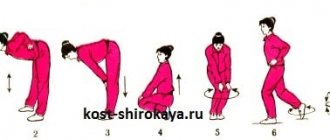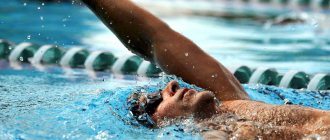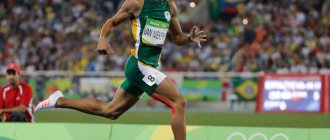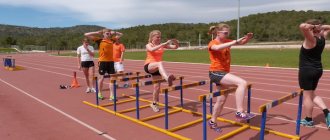Boxing training allows you to very quickly turn a beginner into a real fighter. This is not only a sport, but also a special training system. No system allows you to achieve results like boxing. While in other martial arts, beginner athletes only learn the basics during the first year and cannot yet fight freely, during this period a boxer can learn to successfully fight at different distances, take part in the first competitions and already represent a formidable force on the street.
Main stages of training
While in many striking types of martial arts dozens of kicks and punches are studied, boxing training polishes only a few strikes, increasing the efficiency of this application. As a result, the boxer has a smaller arsenal of striking and defensive techniques, but it has been brought to automaticity . At the same time, neither karatekas, nor taekwondokas, nor adherents of various styles can boast of such efficiency in using blows, because they have very little time left to practice each of them.
As in many sports and martial arts, boxing training includes the following stages in the plan:
- Warm up.
- Main part.
- Physical training.
- Paw work, punching bag and sparring.
Warm-up aims to prepare the body for subsequent loads and prevents the occurrence and development of injuries. It includes:
- a set of running exercises, jumps, lunges, swings;
- moving in stances, changing lanes;
- rotation of limbs, torso, etc.;
- a set of exercises for different body systems, including the ligamentous-muscular system;
- special exercises, including those for developing a reaction, such as “shadow boxing”, jumping rope, etc.
Having prepared the body for the upcoming loads, the training moves on to the main part, where the following tasks are solved:
- studying, practicing and improving the technical elements of combat;
- preparing a boxer for great psychological stress, training confidence;
- development of such qualities as speed of strikes and movements, reaction, endurance, agility, improvement of coordination of movements.
Physically, a boxer prepares during the first two stages of training by performing basic exercises. But separate training is also required, which is aimed exclusively at improving the physical qualities of a fighter. Strength training in boxing has its own characteristics.
The physical and technical development of a boxer is unthinkable without sparring. A boxer must be able to feel his opponent in the ring, keep his distance, beat him tactically and surpass him technically. Working in the air, with a bag or on the pads does not achieve what sparring develops. And above all, this concerns self-confidence. For an unprepared person who does not practice sparring, any collision with a live opponent causes a feeling of fear, he acts constrained, and forgets about the developed technique.
Principles of CT
This training program is formed based on movement through stations. Here you need to maintain a certain pace and complete assigned tasks.
The training takes place as if in a circle. Any hall with a standard volume of shells is suitable for it. You can work at the stadium, at home and outdoors.
First you need to outline the range of stations. Exercises will be performed on them. They are taken from the course of basic or sports-preventive gymnastics.
In terms of development, they are as close as possible to the exercises from a boxer’s special program.
They should be selected in such a way as to develop the muscles that are key to a boxer’s actions. And this:
- shoulder girdle,
- frame,
- legs.
The process should also develop dynamics, power and endurance.
Boxing technical training
It was noted above that there are not many blows in boxing and this allows athletes to develop maximum efficiency in their use. But this does not mean that the development of technology is very monotonous. Despite the small number of strikes, there is a lot of work to be done.
In general, the boxing training program is divided into the following work:
- over the basic technical elements - strikes, defense, movements, escapes and dodges;
- at a long distance;
- at medium distance;
- at close range.
It is not enough to master individual technical elements. All of them must be developed in combination for different situations, both in attack and defense, at different distances. The opponents, starting the fight, begin exchanging blows from a long distance, move to the middle distance and can converge into close combat. This is not a dogma, and everything depends on the training and data of the fighters. If a tall athlete is opposed by a small fighter, it is better for the latter to enter into close combat, depriving the opponent of his advantage of longer arms. The first boxer has the opposite task - it is better for him to fight at a long distance, firing at the opponent at a safe distance.
While working on learning the basic technique, you will begin to master and develop:
- correct fist clenching;
- basic fighting stances;
- movements and movements;
- straight, side blows and uppercuts;
- combination of shock actions with each other and in motion;
- defensive actions - block, dodge, escape, stand, rebound.
It is very important that the blows are placed correctly. Group boxing training does not allow the coach to develop absolutely correct movements and reactions for each fighter - these are not individual classes. He gives general recommendations, and he can have several dozen people in his group at the same time, and everyone has their own understanding of what they saw and heard. In this training format, it is difficult to ensure that all elements are performed correctly by each athlete. Therefore, it is worth thinking about personal boxing training, in which the trainer will achieve clarity and correctness of technical movements in one athlete.
It so happens that during group classes, a boxing coach singles out several especially talented, promising fighters, to whom he pays the main attention and invites them to individual classes. Therefore, if you try and strive to get the most out of yourself, you can earn such attention towards yourself. It all depends on the boxing school itself and the tasks facing the coaching staff.
After mastering the basic technique, they move on to practicing technical elements from different distances. At each of them, attention is paid to the following elements:
- body position;
- single strikes;
- two-hit combinations;
- three-hit combinations;
- four-beat series;
- protective actions;
- counterattacks.
For close-range combat, attention is paid to the moments of leaving and entering close combat. Punch combinations can include straight punches, side punches and uppercuts. The series are structured so that the athlete does not experience monotony in combat. He must hit equally often with his right and left hands at three levels - upper, middle and lower.
From this approach in attack, the defense in boxing “breaks through”, and the enemy is defeated. Otherwise, if the actions in the attack are monotonous, they give the opponent the opportunity to very quickly seize the initiative and impose his own battle with counterattacking and attacking actions. As a result, he emerges victorious on points or early as a result of knockdowns or knockouts.
The combination, in addition to strikes, must include defensive actions: block, escape, dodge, stand, rebound. An important point that is forgotten or deliberately ignored. The development of technical elements at different distances is carried out for the reason that each of them imposes special requirements.
For example, a side blow at close range is delivered so that the palm of the striking hand faces the striker when delivering it. If the hook is thrown at mid to long range, the fist is turned so that the palm of the hand is facing the floor. In both cases, the technical action requires many hours of work on how to hit correctly. Otherwise, the attacking element will be weak and can lead to injury during sparring or when working with a punching bag.
Increase in explosive power
After 2-3 months it is necessary to complicate the program. Explosive strength and anaerobic endurance training is a must. Its principles are:
- Cyclic exercises with your own weight. Consists of push-ups, squats, jumping jacks, sprints and burpees.
- Pull – push and throw. Any heavy and massive things are suitable for this principle, for example: logs, tires, sledgehammers, etc.
- To improve explosive parameters, pushing movements are implemented quickly and sharply.
- Before classes, the muscles are thoroughly warmed up, and stretching is a must.
To develop these indicators, two complexes are proposed:
The first is Improving speed power.
| Exercises | Duration (sec) |
| Sledgehammer blows | 30 |
| Jumping on a tire | 20 |
| Offset push-ups | 10 |
| Jumping | 10 |
| Twists with a punching bag or ball | 20 |
| Throwing the ball to the floor | 20 |
| Swinging edges | 15 |
| Jumping onto a platform 60-70 cm high. | 20 |
| Burpees with accelerations | 15 |
| Barbell throws from bench press position | 10 |
Second. Development of endurance.
| Exercises | Duration (sec) |
| Push the bar with both hands | 30 |
| Swinging a sledgehammer | 30 |
| Burpees + pull-ups | 10 times |
| Throwing the bar with each hand in turn | 20 per hand |
Working on movement
A boxer who moves weakly is just a bag in the ring who will be beaten. That is why during classes, whether group or individual training, a lot of time is spent on the athlete’s movements. Foot speed in boxing is as important a key to victory as a quick, powerful knockout punch. Beginning athletes literally drag their feet after every workout, because people are not used to withstanding such aerobic exercise.
In the Soviet school of boxing, which was promoted in the Youth Sports School, be it in Moscow or in the provinces, throughout the entire lesson, boxers moved forward and backward on their toes without stopping, even when they took a break from performing two- and three-punch series, they continued to move. This approach made it possible to very quickly give the boxer ease of movement.
All punches are thrown in motion, regardless of whether the boxer is moving forward or backward, left or right. He must learn to attack in all cases, not only when he goes on the offensive. Moving backwards from the attack, he must strike, thereby disrupting the enemy’s attack. Moving to the side in a circle allows you to find yourself in a winning position and change places with the attacker. But all these attacking and effective counterattacking actions are practiced in motion. But how to develop them if you need to perform tens of thousands of repetitions, and after 100-200 repetitions your legs are already tired? From the first days you have to do a lot of moving and movement, so that soon the fighter can easily move on his feet for hours.
Protection aspects
For beginners, the best method is blocking. It allows you to maintain striking distance without taking damage, and also blocks attack angles.
The technique can be used to protect the head and body. In the first case, the technique is as follows:
- Gloves are brought closer to cover the face.
- Raises the right glove to block attacks from the left side.
- The left glove is raised to defend against an assault from the right.
In the second situation, the algorithm is as follows: the elbows are placed close to the body, the right one is lowered to block attacks from the left side, and the left one is against those coming from the right.
The following aspects are also observed:
- Block yourself, don't chase the blows.
- Don't take your eyes off your opponent.
- Stay on both feet.
- Attack back.
- Step back, leave the dangerous distance.
- Control your opponent's lead hand.
Circuit training
Circuit training in boxing is a very important element of a boxer’s physical training, as it allows him to develop special qualities that are important in fights. A boxing fight requires good strength training and developed endurance. But it won’t be possible to develop them using traditional methods, as bodybuilders do. Such a sport with its linear training is not suitable for the ragged rhythm of combat, where the position changes every second. We need training in the same ragged mode, when the load changes very quickly.
This is achieved by performing several approaches, in each of which you need to do 4-5 exercises for different muscle groups without stopping. For example, in one approach you need to perform sequentially:
- 10-15 pull-ups;
- 20-30 push-ups;
- 25-35 body twists;
- 20 lunges with the left and right leg;
- jumping rope 100 times.
This is one approach, all the exercises in it are performed one after another without rest, without stopping. Between approaches, the athlete should rest for a minute or two, and then continue. Any exercise on this list can be replaced with another that will load the same muscle groups. For example, a pull-up can be replaced with an exercise in which a block is pulled behind your back. The main thing is that circuit training in boxing loads as many muscles as possible in one approach. Make sure you do the exercises quickly. This is not a weightlifting sport! There is no need to squeeze out a lot of weight; the load should be sufficient to perform the specified number of times.
Circuit training in boxing allows you to develop various sports qualities of a fighter such as speed, strength, endurance, speed-strength endurance and speed strength, not individually, but in combination. If individual classes are conducted, the coach selects special effective complexes for each fighter that allow them to eliminate weaknesses.
Classes for beginners
A special set of exercises is performed here. It is also suitable for home training. For them you will need a small arsenal of shells:
- Medicine ball. Suitable weight: 4-10 kg.
- Prefabricated dumbbells.
- A bar weighing no more than 10 kg.
Various exercises are performed with them for 15 repetitions or for a while. The stages of training are:
- Squats with a medicine ball. Press it to your chest and squat. On the way up, throw it up sharply.
- Lunges with the same projectile. Change legs. And throw it up while jumping.
- Push-ups with clapping.
- Throwing the bar in front of you. Duration – 2 minutes.
- Swinging the press using the crunching method. The body rotates from left to right.
- Dumbbell pump. Their weight: 5-8 kg. The position is standing, straight. One hand reaches to the armpit, the other to the knee. The body sways from side to side. The lateral abdominal muscles are involved. Duration – 2 minutes.
- Pushing the medicine ball away from the shoulder. The projectile is thrown at the wall. This is a simulated attack. Number of approaches: 3-4. Each lasts 3 minutes.
Between each stage there is a pause of 1-15 minutes. It is advisable to gradually reduce it to 40-60 seconds.
Work on shells
Work on the paws and with the bag occupies a special place in boxing. If you develop impact force with a heavy bag, then working on your paws allows you to position the equipment correctly. Individual training does this very effectively and quickly, during which the coach can pay a lot of attention to one athlete. Such individual lessons very quickly turn a beginner into a trained fighter. In group classes, the trainer will not physically have time to pay as much attention to each trainee, which is why there is such a difference in the results.
You need to work not only on heavy, but also on light pears, including pneumatic ones. Often, gyms are equipped with wall-mounted punching bags, which allow more students to simultaneously develop punching power. Equipment training can be included in the main part of the training, as well as sparring, which is an integral part of a boxer’s training. Before training, you need to check with a sports doctor - boxing requires good health!
Within the walls of the “YourRevolution1905” club, we are ready to professionally help you learn to box or improve your level as a boxer. Entire sets of exercises developed by certified specialists, nutritional recommendations, “smart” weighing, classes conducted by a Master of Sports in boxing and much more, all this will help you achieve your goal as effectively as possible. For the most effective and quick results, you can train individually (one-on-one with a trainer) or in mini-groups of up to ten people. Come to our classes and we will help you become the best version of yourself!
Who is not recommended to exercise?
The rules for admission to boxing are the same as in any active sport; first of all, good health. To enter the boxing section, the child will need to take a certificate from a doctor, and not a formal one, but issued after an appropriate medical examination and examination. This approach guarantees the directors of the sports school that their future student is healthy and has no medical contraindications for engaging in active sports. For parents, this is a guarantee of peace of mind that their child is able to endure quite difficult loads without harm to health.
It must be borne in mind that some, at first glance, insignificant health deviations are a categorical contraindication for boxing. In particular, these are any visual impairment, hearing impairment, diseases of internal organs, musculoskeletal system, scoliosis, and some skin diseases. It is better for such children to choose another sport, for example gymnastics, by doing which they will get rid of their illness and perhaps achieve good results.
Moral qualities also play a huge role. There are no hard sparrings in the first year of training, but increasing intensity of training, unconditional discipline and perseverance must certainly be embedded in the character. The weak in spirit will not take root here, but physical characteristics, even if not of the best quality initially, will grow before our eyes. Children get in shape very quickly while rapid development is underway.
Playing sports in no way cancels out school work; on the contrary, poor students in some sections are simply expelled for a while until their grades are corrected. The practice is not bad and very correct.











